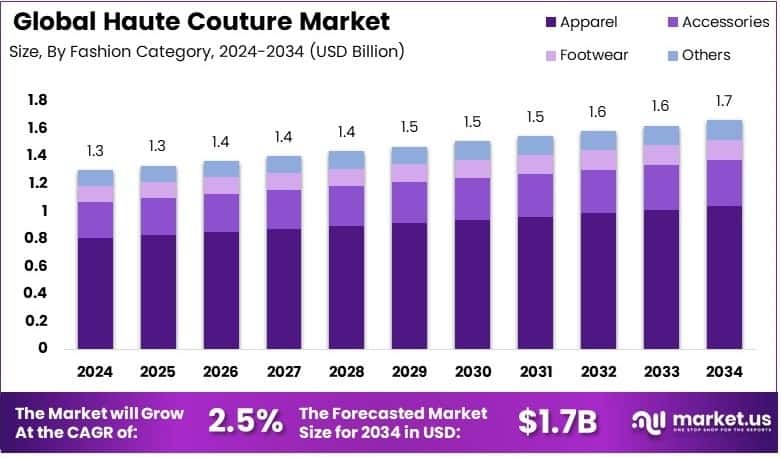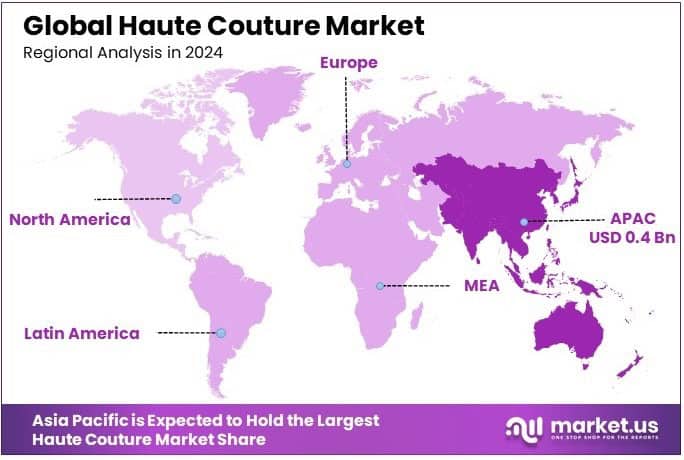Table of Contents
Introduction
New York, NY – March 11 , 2025 – The Global Haute Couture Market is projected to reach approximately USD 1.7 billion by 2034, up from USD 1.3 billion in 2024, reflecting a CAGR of 2.5% during the forecast period 2025–2034.
The Haute Couture market represents the pinnacle of fashion, characterized by meticulously handcrafted garments, exclusive designs, and a clientele comprising high-net-worth individuals. Haute Couture, a French term meaning “high sewing” or “high dressmaking,” refers to the creation of custom-fitted garments, requiring extensive craftsmanship, premium materials, and adherence to strict guidelines set by the Fédération de la Haute Couture et de la Mode (FHCM) in Paris.
The Haute Couture market is a niche segment within the broader luxury fashion industry, driven by heritage brands, emerging designers, and affluent consumers seeking exclusivity. Growth within this market is fueled by rising global wealth, increasing demand for personalized luxury, and the expansion of digital platforms enabling direct engagement between designers and elite clients. Additionally, evolving fashion sensibilities, particularly in Asia and the Middle East, have led to an uptick in interest, as new wealth accumulates in these regions.
The demand for Haute Couture is further propelled by high-profile red-carpet events, social media influence, and celebrity endorsements, which continue to elevate its prestige. While the market remains highly exclusive, new opportunities are emerging through strategic brand collaborations, sustainable couture initiatives, and digital innovations such as virtual fittings and AI-driven customization.
The integration of metaverse fashion and NFT-backed couture collections is also reshaping how luxury consumers perceive exclusivity, opening doors to a broader, tech-savvy audience. Despite its limited customer base, the Haute Couture market continues to thrive as a symbol of ultimate craftsmanship, artistic expression, and heritage, ensuring sustained relevance in the evolving luxury fashion ecosystem.

Key Takeaways
- The Haute Couture Market was valued at USD 1.3 Billion in 2024 and is projected to reach USD 1.7 Billion by 2034, growing at a CAGR of 2.5%.
- Apparel led the fashion category segment, accounting for 62.3%, driven by strong demand from luxury consumers.
- Female Couture dominated with an 83.3% share, reflecting the prominence of women’s fashion in haute couture.
- Daily Wearing was the leading application segment with 73.2%, highlighting the demand for exclusive fashion pieces for personal use.
- Private Clients constituted 53.4% of the market, driven by high-net-worth individuals seeking custom couture designs.
- APAC held a 31.3% market share (USD 0.4 Billion), supported by rising affluence and luxury spending in the region.
Report Scope
| Report Features | Description |
|---|---|
| Market Value (2024) | USD 1.3 Billion |
| Forecast Revenue (2034) | USD 1.7 Billion |
| CAGR (2025-2034) | 2.5% |
| Segments Covered | By Fashion Category (Apparel, Accessories, Footwear, Others), By Type (Female Couture, Male Couture), By Application (Catwalk, Daily Wearing), By End User (Private Clients, Celebrities and Public Figures, Museums and Exhibitions, Fashion Collectors, Others) |
| Competitive Landscape | Dior, Chanel, Giorgio Armani Prive, Atelier Versace, Jean Paul Gauthier, Ellie Saab, Zuhair Murad, Ralph&Russo, Givenchy, Julien Fournie, Saint Laurent, Valentino, Stephane, Shiaparrelli, Viktor&Rolf, Giambattista Valli, Guo Pei, Iris Van Herpen, Yuima Nakazato, Georges Hobeika |
“Get Instant Access to a Sample of Our Report and Uncover Valuable Market Insights at https://market.us/report/haute-couture-market/request-sample/
Emerging Trends
- Digitalization and Virtual Shows: Fashion houses are increasingly adopting digital platforms to showcase their collections. Virtual fashion shows and online showrooms have become prevalent, allowing global audiences to access haute couture designs remotely.
- Sustainability and Ethical Practices: There is a growing emphasis on sustainable and ethical practices within the industry. Designers are incorporating eco-friendly materials and processes, reflecting a commitment to environmental responsibility.
- Integration of Technology: The fusion of fashion and technology is evident, with designers experimenting with digital fabrics and 3D printing techniques to create innovative designs.
- Cultural Collaborations: Collaborations between luxury brands and designers from diverse cultural backgrounds are on the rise, enriching collections with unique perspectives and craftsmanship.
- Personalization and Customization: Clients are seeking more personalized experiences, leading to a surge in demand for bespoke designs tailored to individual preferences.
Top Use Cases
- Red Carpet Events: Celebrities often choose haute couture gowns for prestigious events, showcasing the craftsmanship and exclusivity of these designs.
- Weddings: Bridal haute couture offers custom-made gowns that cater to the unique desires of brides seeking exclusivity on their special day.
- High-Profile Galas: Philanthropic events and galas provide a platform for showcasing haute couture, reflecting the wearer’s status and appreciation for artful design.
- Fashion Exhibitions: Museums and galleries exhibit haute couture pieces, recognizing them as significant contributions to art and culture.
- Editorial Features: Fashion magazines feature haute couture designs in editorial spreads, influencing trends and inspiring readers.
Major Challenges
- High Production Costs: The meticulous craftsmanship and premium materials result in substantial production expenses, limiting accessibility.
- Limited Customer Base: The exclusivity of haute couture confines its appeal to a niche market of affluent individuals.
- Competition from Ready-to-Wear: Luxury ready-to-wear collections offer designer quality at relatively lower prices and faster delivery timelines, drawing attention away from haute couture.
- Cultural Sensitivity: Global expansion requires adaptation to diverse cultural preferences, presenting challenges in design and marketing strategies.
- Sustainability Concerns: Addressing environmental impacts and adopting sustainable practices are imperative to meet evolving consumer expectations.
Top Opportunities
- Emerging Markets: Expanding into regions with growing affluent populations presents opportunities for market growth.
- Digital Engagement: Leveraging digital platforms for marketing and virtual fashion shows can broaden reach and engage younger audiences.
- Sustainable Practices: Embracing sustainability can attract environmentally conscious consumers and enhance brand reputation.
- Collaborations: Partnering with artists and designers from various disciplines can lead to innovative collections and expanded appeal.
- Experiential Retail: Creating immersive retail experiences can enhance customer engagement and differentiate brands in a competitive market.
Key Player Analysis
The global haute couture market in 2024 continues to be driven by heritage brands and emerging avant-garde designers, shaping the luxury fashion landscape. Dior and Chanel maintain their dominance with timeless craftsmanship and consistent innovation, appealing to ultra-high-net-worth clients.
Giorgio Armani Privé and Atelier Versace focus on refined elegance and contemporary luxury, catering to red carpet clientele. Jean Paul Gaultier’s rotating guest designer model breathes fresh creativity into the brand, while Elie Saab and Zuhair Murad remain leaders in intricate embroidery and Middle Eastern glamour. Ralph & Russo, despite past financial challenges, strives for resurgence.
Givenchy and Saint Laurent integrate modern sophistication into their couture offerings. Valentino, under Pierpaolo Piccioli, is a market leader in romantic, ethereal designs, while Schiaparelli and Viktor & Rolf push artistic boundaries. Giambattista Valli, Guo Pei, Iris Van Herpen, Yuima Nakazato, and Georges Hobeika contribute avant-garde aesthetics, expanding haute couture’s artistic and global appeal.
Major Companies in the Market
- Dior
- Chanel
- Giorgio Armani Prive
- Atelier Versace
- Jean Paul Gauthier
- Ellie Saab
- Zuhair Murad
- Ralph & Russo
- Givenchy
- Julien Fournie
- Saint Laurent
- Valentino
- Stephane
- Schiaparelli
- Viktor & Rolf
- Giambattista Valli
- Guo Pei
- Iris Van Herpen
- Yuima Nakazato
- Georges Hobeika
Regional Analysis
Asia Pacific Leads the Haute Couture Market with Largest Market Share of 31.3% in 2024
The Asia Pacific region holds a dominant position in the global haute couture market, accounting for 31.3% of the total market share in 2024. The market in this region is valued at USD 0.4 billion, driven by the increasing number of high-net-worth individuals, growing fashion consciousness, and rising demand for luxury apparel, particularly in countries such as China, Japan, South Korea, and India.
China, in particular, has emerged as a key market, benefiting from a rapidly expanding affluent class and an evolving luxury fashion culture. The presence of major luxury fashion houses, rising disposable income levels, and a growing inclination toward exclusive, personalized fashion experiences are further fueling market growth. Additionally, high-profile fashion events, digital transformation in luxury retail, and the increasing influence of international designers contribute to the region’s strong position in the market.

Recent Developments
- In 2023, Kering finalized the acquisition of a 30% stake in Valentino, following regulatory approvals and the terms set in July. This investment will be accounted for under the equity method, solidifying Kering’s presence in the luxury fashion sector.
- In 2024, Alessandro Michele took on the role of creative director at Valentino, marking a new chapter for the brand. Previously at Gucci, Michele’s move put an end to widespread industry speculation about his next venture in the fashion world.
- In 2025, Sociedad Textil Lonia secured an agreement to acquire Maison Christian Lacroix. The Spanish company expanded its luxury portfolio with this acquisition, though financial details of the deal remain undisclosed.
Conclusion
The Haute Couture market remains a symbol of exclusivity, driven by high-net-worth individuals and luxury fashion enthusiasts. Growth is fueled by increasing global wealth, rising demand for bespoke designs, and digital innovations enhancing accessibility. Asia-Pacific leads in market expansion, with emerging affluence shaping luxury consumption. Sustainability, cultural collaborations, and technology integration are key trends influencing the industry’s evolution. Despite challenges like high costs and a niche customer base, strategic partnerships, digital engagement, and experiential retail continue to sustain market relevance in an evolving luxury landscape.
Discuss Your Needs With Our Analyst
Please share your requirements with more details so our analyst can check if they can solve your problem(s)





